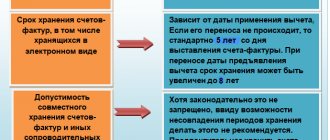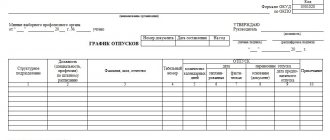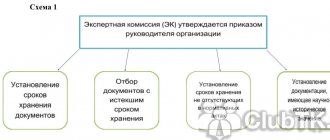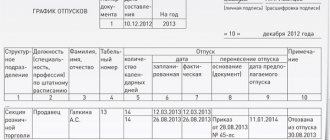Work time
Denis Pokshan
Expert in taxes, accounting and personnel records
Current as of May 10, 2019
Does the schedule apply to the organization’s personnel documents and, if so, what period is established by current legislation for its storage? From what date should the period established by law be calculated? Let's talk about everything related to storing a vacation schedule: terms, order, rules.
Why save personnel documents, and what determines their retention period?
Storing personnel documents is the responsibility of all companies and individual entrepreneurs. This is determined by Art. 17 of Law No. 125-FZ on archiving in the Russian Federation. Everyone is equal before this requirement of the law: both businessmen and government agencies.
Personnel documentation occupies a significant place in the total volume of papers processed at the enterprise. If a company has several hundred or thousand employees, the number of personnel documents can reach several thousand. But micro-companies that employ 2-3 people cannot do without these kinds of documents. And all of them are subject to storage for legally established periods.
The main feature associated with the storage period of personnel documents is the length of the period during which they cannot be destroyed. For example, information related to the personnel of a company is subject to long-term storage (75 years or for the entire period of the company’s existence). Such personnel documents include employment contracts and additional agreements thereto, personal cards of employees and other documents created by the company related to the labor relationship between the employee and the employer.
The shelf life of cases generated in the personnel service is influenced by many factors. For example, due to the different degrees of importance of the vacation schedule and staffing schedule, the storage periods for these documents differ by 5 times (1 year and 5 years, respectively).
We will consider in more detail the features of the retention periods for personnel documentation in the following sections.
Why is it necessary to keep a vacation schedule for previous years?
Upon expiration, the vacation schedule for the past period no longer has legal force. However, in a number of cases, the information reflected in this document can be an excellent help in the event of emergency situations: disputes between an employee and employers, errors when drawing up orders for granting leave, miscalculations when calculating payments related to sanatorium treatment, etc.
In addition, with a significant number of personnel, when drawing up a vacation schedule for the next calendar year, disagreements may arise among employees regarding the order in which they are provided. In this regard, an outdated schedule will help to obtain an objective picture of vacation time for the past period, as well as analyze the difference between planned and actually used vacations.
In addition, the presence of last year’s schedules provides the opportunity for responsible persons to carry out future forecasting of employee wishes and planning the company’s work activities.
Shelf life table
The cabinet with personnel documentation consisted of several compartments. Accountant Savina N.P. began sorting through papers from the first compartment. The results of her work are presented in the table.
From the contents of the last column of the table it follows that part of the personnel documentation needs to be restored, since its storage period has not yet expired. And other papers simply take up space because their standard storage period has expired. We will talk about the consequences of analyzing personnel documentation in the next section.
Archiving employment contracts of dismissed workers
InfoQuestion Hello, how to archive employment contracts with employees? At the end of the year, file a volume of employment contracts and additional agreements only for dismissed employees? Or all contracts and additional agreements to them concluded in the past calendar year? The same question concerns the written consent of employees to the processing of personal data. Thank you. Answer An employment contract is the main document regulating the labor relations between the employee and the employer, who are parties to the employment contract. The legislation does not establish a specific procedure for storing employment contracts, however, in practice, most often employment contracts are stored in the employee’s personal file. At the same time, keep the personal files of only working employees in the HR department. Transfer the files of resigned employees to the archives for storage. Options for separately forming employment contracts are also possible.
The way you store agreements does not play a big role. The main thing is to keep order in the archive and observe the retention period of employee employment contracts, so that the head of the organization does not face administrative or even criminal penalties for violating the rules. Storage period of employee employment contracts In order to determine the storage period of the contract, it is necessary to indicate the type of document and its storage method. There are 3 types of documents:
- Short-term (papers are stored for less than 10 years)
- Long-term (papers are in the archive for more than 10 years)
- For permanent storage. Destruction of such files is not provided.
Determine the storage period by document type:
- Core contracts, as well as documents that are directly related to the activities of the organization. They are stored in archives for no longer than 5 years.
- Business contracts.
At the same time, the legislation does not establish a specific procedure for storing employee consent to the processing of personal data. Therefore, in this case, the order will depend on how consent is formed in your organization. Because the storage period for consents coincides with the storage period for personal files, then in this case two options are also possible (i.e., consents are stored in the employee’s personal file or consents are stored in a separate folder). Thus, if consents are stored in the personal files of employees, then transfer the files of resigned employees to the archive for storage. If consents are stored in separate folders, then in this case, it is advisable to transfer them for archival storage only after the employee’s dismissal from a particular organization.
Rules approved by the decision of the Rosarkhiv board of February 6, 2002). Keep the personal files of employees for 75 years, keep the personal files of managers, members of the governing, executive, control bodies of the organization, employees with state and other titles and awards - permanently (Article 656 of the list approved by order of the Ministry of Culture of Russia dated August 25, 2010 No. 558 ). How to archive employment contracts with employees?
- Important Topics:
- HR records management
- Document storage
Question: How to correctly stitch together employment contracts of dismissed employees for archiving? I know how to sew orders for personnel and do it every year, but I don’t know how to do employment contracts.
I have two options: - stitch it together with orders for personnel; — staple employment contracts into a separate folder. Sew personal documents with four pins into a hard cardboard cover (binder) or bind them in such a way that you can read the text of all documents, including dates, visas and resolutions. Before filing (binding), remove staples from all documents. This procedure follows from the paragraph of the Rules approved by the decision of the Rosarkhiv board of February 6, 2002. At the beginning of the case, file the forms for the internal inventory of the case documents, and at the end - the forms of sheets-certifiers of the case (clause of the Rules, approved by the decision of the Rosarkhiv board of February 6 2002). Keep the personal files of employees for 75 years, keep the personal files of managers, members of the governing, executive, control bodies of the organization, employees with state and other titles and awards - permanently (Article 656 of the list approved by order of the Ministry of Culture of Russia dated August 25, 2010 No. 558 ).
Upon dismissal of an employee
In case of dismissal, personal files, contracts and other documents must be kept in the archives. For this purpose, folders are created where files are filed. If the organization's staff changes quickly, then a new folder is created every year. If, on the contrary, there are few employees, then one folder may contain documents for several years. Papers are separated by year using a blank sheet of paper. The date of filing can be indicated either in the year the person entered the position or in the year of dismissal.
How you store agreements doesn't matter much.
The main thing is to keep order in the archive and observe the retention period of employee employment contracts, so that the head of the organization does not face administrative or even criminal penalties for violating the rules.
Working with archives
Representatives of public or private structures are obliged to preserve information about former employees for a regulated period (up to 75 years). To gain access to personal files, individuals or legal entities must submit a corresponding request to the archive and clarify the purpose of obtaining them.
Depending on the situation and storage period, you need to contact either the archival service or the personnel department of the company where the person about whom you need to obtain data for one purpose or another worked. They are often requested to receive compensation, benefits, social or pension benefits. When the document has been used for its intended purpose, it will need to be returned to the archive.
It is possible to provide archival information upon request in electronic form. Sometimes such data (especially those stored for 20 years or longer) can be found in special departments of libraries, archives of government agencies or scientific organizations. In many ways, it all depends on the specific field in which the person worked.
There can be a large number of reasons why the personal file of an employee who worked at the company many years ago may be useful. Therefore, personnel officers must comply with the law and keep records of document storage in accordance with the specified period.
The need to revive old treaties
A logical question in a situation with the length of storage of employment contracts or employee work files is why they may be needed 20 or 30 years after the person stopped working for the company.
The fact is that the reasons why they may be required are completely different. In particular, this data must be provided in the event of requests from competent authorities, for example, courts, other representatives of law enforcement services or other government agencies.
This may be necessary during legal proceedings, when it is required to know for sure whether a particular person worked at a certain period in a specified company. Moreover, the statute of limitations for cases can be completely different.
Another case is tax proceedings. Sometimes it becomes necessary to certify that the employee represented the interests of the company. Sometimes former employees themselves need to confirm such data, and the goals may be different. This is protection before law enforcement agencies, confirmation of receipt of funds within a certain period, etc.
Decades later, descendants may need information when accepting an inheritance (and not only). It is impossible to collect all the cases in which contracts may be required in a list, since there are a lot of them.
Although the law requires that employment contracts, books or personal records of dismissed employees be kept for 75 years, in practice this is not always possible. The first reason is that not all organizations or government agencies operate during such a period. If a company goes out of business, the remaining documents that need to be stored for a long time or indefinitely should be transferred to special archival services. Interested parties can obtain them upon request based on certain documents.
Employment contract: types, procedure and retention periods
Each employee hired for a vacant position must enter into an employment contract that will regulate the relationship between the parties. It contains information such as:
- information about the organization and employee;
- position held;
- place and nature of work;
- working hours and rest schedule;
- rights and obligations of the parties;
- salary amount,
- the period of labor relations and other provisions provided for by the legislation of the Russian Federation.
On the territory of Russia, labor relations are regulated by the norms of the Labor Code of the Russian Federation of December 30, 2001 No. 197-FZ. The law establishes that the contract is concluded in writing in two copies for each of the parties, one. In the HR department, a personal file is created for each employee, where the signed employment document is filed.
Lawyer's opinion Dmitry Ivanov Legal support center Ask a lawyer a question
This article talks about typical ways to resolve the issue, but each case is unique. If you want to find out how to solve your particular problem, call:
- Moscow.
- Saint Petersburg.
Or on the website. It's fast and free!
Employment contracts can be concluded for an indefinite period (indefinite) and a certain period (fixed-term).
Where should a copy of the employment contract that remains with the employer be kept?
An employment contract is the main document regulating the labor relations between the employee and the employer, who are parties to the employment contract.
The legislation does not establish a specific procedure for storing employment contracts, however, in practice, most often employment contracts are stored in the employee’s personal file. At the same time, keep the personal files of only working employees in the HR department. Transfer the files of resigned employees to the archives for storage.
Keep the personal files of employees for 75 years, and keep the personal files of managers, members of the governing, executive, and control bodies of the organization, employees with state and other titles and awards, forever.
“There is not a word about the registration of employment contracts in the Labor Code,” some inexperienced office workers may object, and they will be only partly right. Irina Murnina, an office management consultant, author and seminar leader, shares her practical experience.
The Labor Code of the Russian Federation describes in great detail the content, terms, procedure for concluding many other aspects of the employment contract, the most important document for the relationship between the employee and the employer.
Employment contracts are drawn up, registered and stored by the organization's personnel service.
Where the staffing level is small (in practice, no more than 100 people), personnel work, as a rule, is assigned to the chief accountant or the manager's secretary.
The assignment of responsibilities for conducting personnel work must be formalized by order of the manager. Accordingly, employment contracts are maintained and stored either by the organization’s personnel officers or by officials authorized to conduct personnel work.
The date of the employment contract is indicated at the beginning, below the name of the document - the employment contract. Pay special attention to this date. In accordance with Art. 68 of the Labor Code of the Russian Federation, an order (instruction) on hiring is announced to the employee against signature within three days from the date of signing the employment contract.
The optimal option is when the employment contract and employment order are drawn up on the employee’s first working day. The agreement is drawn up, dated, signatures and the seal of the organization - on the spot, it would seem, it can be handed over to the employee (Article 67).
But it’s too early to issue it, because after registration the employment contract must be entered into the registration form.
“There is not a word about the registration of employment contracts in the Labor Code,” some inexperienced office workers may object to me, and they will be only partly right, because the Labor Code is a federal law that should not and cannot prescribe obvious facts in detail.
What about the numbering?
Registration of a document records the fact of its creation or receipt by the organization. Let’s say the contract was drawn up, signed, the date was set, but the number was not. That is, the document was created, but this fact was partially recorded. Either they forgot or didn’t want to: “Why do we need extra bureaucracy?”
Well, then in court the problem may arise of proving the authenticity of such an agreement, its execution in the manner prescribed by law and within the time limits established by law.
And the law says absolutely clearly: “In writing no later than three working days from the date of the employee’s actual admission to work” (Article 67 of the Labor Code of the Russian Federation). And the one who violated this law will be guilty.
Employment contract
If registration is carried out on paper, then such a journal must have numbered pages, stitched, laced and certified by the signature of the head and the seal of the organization.
For electronic registration, it is necessary to provide for the inability to move numbers, although moving the numbers of employment contracts seems to be unrealistic. After all, one copy is kept by the employee.
And taking into account those who have already quit... But in practice, everything is possible with us, so it’s better to play it safe.
The form of the journal is arbitrary, but all the necessary data is entered into it, allowing you to quickly find the document.
The journal of registration of employment contracts, for example, may contain the following chapters:
- Date and number of the employment contract Full name an employee with whom an employment contract has been concluded.
- Position, place of work, contact phone number.
- Type of work (main, part-time).
- Duration of the employment contract.*
- Availability of a probationary period (start and end date).
- Date and number of the employment order.
- Dates and numbers of amendments to the employment contract.
- The number of the case in which the employment contract is filed.
* Indicate fixed-term or for an indefinite period, indicate the start date of work, for fixed-term employment contracts - also the end date.
We invite you to familiarize yourself with: Lease agreement with the right to purchase real estate
If necessary, you can supplement this table with other columns or exclude positions that are unnecessary, from the point of view of a specialist.
The contract number can be a regular serial number according to the order of registration, or it can be supplemented with a digital or letter designation of the structural unit to which the employee was hired, and other additional codes that allow for prompt and high-quality search and information and reference work with employment contracts.
The employment contract is drawn up, executed and signed by both parties in two copies. For certain categories of employees, it may be possible to draw up an employment contract in a larger number of copies (Article 67 of the Labor Code of the Russian Federation).
The signature of the employer's representative is affixed with the seal of the organization (for employers - legal entities), and for the employee, the full passport data is indicated.
One copy of the registered employment contract is handed over to the employee against a signature on another copy, which will be kept by the employer (See the above article of the Labor Code).
Moreover, the employee personally and by hand makes a note on the original contract: “One copy of the employment contract dated 00.00.
The employee may also sign for receipt of a copy of the employment contract in the appropriate column of the Employment Contracts Register. This is completely optional, is not regulated by law, and the absence of a signature in the journal (unlike the original employment contract) is not a violation.
In practice, quite often an employment contract is drawn up in one copy, which is kept by the employer. At best, the employee is given a certified copy or simply (without certification) a photocopy of the employment contract.
We remind you that a photocopy is not a document, and such “innovations” in order to save time and/or hide direct information from the employee about his work in a given organization are a clear violation of the law, in particular, the already mentioned Article 67 of the Labor Code.
You shouldn’t expect that you can somehow “get away with it.” The case may not go to court, but the next inspection will reveal this violation, will definitely punish you and will force you to comply with the violated rule of law within a month. So “saving time and paper” at the current stage may backfire in the future.
Important! The written form of concluding an employment contract, drawing it up in two copies and then handing over one copy to the employee is mandatory, both for the main job and for part-time work.
The copy of the employment contract that remains with the employer is usually filed in a personal file (for civil servants), which is stored in accordance with Art.
656 of the List of standard administrative archival documents generated in the process of activities of state bodies, local governments and organizations, indicating storage periods, indicating storage periods of 75 years with subsequent delivery to the archive.
If the personal files of employees are not maintained, then the employees’ employment contracts are formed into a separate file.
Currently, the community of record managers and archivists is discussing the feasibility of reducing the storage period of personnel documents to 50 years. But even with this approach, the shelf life of employment contracts remains very significant, i.e.
These documents serve as an evidence base if problems arise not only during the period of work for a particular employer or immediately after dismissal, but during the period of calculating an old-age pension, in case of incorrect filling out, or loss of the work book.
With the help of employment contracts, they confirm periods of work, the presence of harmful and (or) dangerous working conditions and many other factors affecting the size of the pension, which for all of us, like winter for public utilities, will come completely unexpectedly, but inevitably.
I.V. Murnina
office management consultant, author and seminar presenter
- information about the organization and employee;
- position held;
- place and nature of work;
- working hours and rest schedule;
- rights and obligations of the parties;
- salary amount,
- the period of labor relations and other provisions provided for by the legislation of the Russian Federation.
On the territory of Russia, labor relations are regulated by the norms of the Labor Code of the Russian Federation of December 30, 2001 No. 197-FZ.
The law establishes that the contract is concluded in writing in two copies for each of the parties, one.
In the HR department, a personal file is created for each employee, where the signed employment document is filed.
This article talks about typical ways to resolve the issue, but each case is unique. If you want to find out how to solve your particular problem, call:
- Moscow.
- Saint Petersburg.
It is filled out during the entire time a person works in the organization, and is started after the order of appointment to the position is issued.
Saving data
All files of dismissed employees must be stored for the period that is regulated for a particular document. Dismissal orders, employment contracts, vacation applications, etc. are stored separately. Papers must be filed in chronological order. If there is no archive in the company’s office, they should be placed in a special fireproof cabinet. It must be remembered that storing employment contracts and personal files of working and dismissed employees in one place is not allowed.
As for the periods of storage of personal files of employees after dismissal, these rules were approved by the Board of Rosarkhiv. They do not apply to documents related to former employees and must be disposed of within 10 years or less.
By law, the storage period for contracts and other papers is 75 years. This list includes:
- personal cards of people fired in 2003 or earlier;
- travel affairs of employees working outside the country;
- information about income, property and liabilities of employees;
- rehabilitation data;
- original copies of personal documents of dismissed employees - work books, certificates of qualification, certificates, certificates, etc. They should be stored during this period until required;
- acts of acceptance and transfer of personal files during transfer (only for employees of government agencies);
- papers about the subject of personal data (notification and consent to the processing of personal information).
Other documents in the archive should not be preserved for so long. In particular, the personal cards of those dismissed after the beginning of 2003 are in it for no more than 50 years. The following are stored for five years:
- resumes and autobiographies of those fired;
- characteristics;
- official and memos;
- travel certificates;
- copies of orders and extracts from them;
- statements.
If a person was never hired, then all documentation about him is stored in the archive for one to three years. HR or accounting representatives must strictly adhere to these rules as required by law.
Formation of a personal file
The procedure for forming labor relations with an employee is regulated by the Labor Code of the Russian Federation. It contains such a concept as personal data, which contains all the information about a person that his employer needs when applying for a job. The rules for their storage and use are established by the employer.
As for the formation of a personal file for each employee, the organization decides independently whether to open them for each individual or only for representatives of the management team. It is filled out during the entire time a person works in the organization, and is started after the order of appointment to the position is issued.
Documents included in the personal file are filed and stored in a safe as they are received. All changes are made by representatives of the HR department or an accountant. The list of documents may differ depending on the organization, but if we are talking about a government structure, it looks like this:
- inventory (added as received);
- questionnaire;
- personal sheet;
- autobiography or resume;
- copies of certificates of education and employee’s passport;
- in case of changes in personal data - certificates and documents that confirm this;
- orders on appointments, transfers, business trips, vacations, etc.;
- employment contract;
- certification and other data.
If any document is removed from a personal file or the originals are replaced with copies, this must be reflected in the inventory. When the case is closed, a resignation letter and a copy of the order are filed, then it is transferred to the archive for storage.
Document retention periods
When putting your organization’s personnel records in order, be very careful when destroying personnel documents. According to paragraph 1 of Article 17 of the Federal Law No. 125-FZ “On Archival Affairs in the Russian Federation”, “organizations and citizens engaged in entrepreneurial activities without forming a legal entity are obliged to ensure the safety of archival documents, including documents on personnel, within the deadlines their storage” established by law.
The storage periods for documents are defined in the List of standard management documents accompanying the activities of organizations indicating storage periods, approved by the Federal Archive (hereinafter referred to as the List). The list is intended for use as the main regulatory document when determining storage periods and selecting standard management documents for storage and destruction, that is, common to all or most organizations (including non-governmental ones). The storage periods for personnel documents are presented in the table on p. 89.
Section 8.1 of the List provides storage periods for documents related to the hiring, transfer and dismissal of employees. Thus, employment contracts, orders for admission, transfer, dismissal, personal cards of form No. T-2, personal accounts of employees, personal files and registration forms for these documents have a shelf life of 75 years. Unclaimed work books, a book of records of work books and inserts for them are stored for 50 years. The storage periods for documents on personnel are established by the List of standard management documents accompanying the activities of organizations, indicating the storage periods. All specified documents must be submitted to the archives. The personal files of dismissed employees are transferred to archival storage for 75 years. The personal files of the company's managers are kept permanently.
Temporary storage periods are applied by all organizations without exception, and permanent ones are applied by those state and municipal institutions whose documents are received for storage in the relevant archives, as well as non-governmental organizations with which agreements have been concluded, that is, sources of archive acquisition.
Retention periods for personnel documents
Procedure for destroying vacation schedules
Documents with an expired storage period are subject to mandatory destruction. Otherwise, the personal data of company employees may become available to unauthorized persons, and ensuring proper storage conditions may require unnecessary costs associated with an increase in location.
Outdated documentation is disposed of in several ways:
- destruction on a shredder;
- cutting (grinding) manually;
- burning.
At the end of the current year, the head of the personnel service or other responsible employee draws up an inventory of documents to be destroyed. At the beginning of the calendar year and as necessary, the manager issues an order to create (if there is none) or appoint a commission for the destruction of documentation at the enterprise.
The order is drawn up in free form. An example order can be downloaded from the link below.
This commission, as part of its activities, regardless of the chosen method of destruction, draws up an act of destruction, which is signed by all its members and approved by the head of the organization.
Such an act shall contain at least the following information:
- name of the document to be destroyed;
- its shelf life;
- method of destruction.
Read more about document destruction in our material.
Employee personal card
The main document for registering the personnel of an enterprise is a personal card (unified form No. T-2). which is established for each employee hired for permanent and temporary work. The form was approved by Decree of the State Statistics Committee of Russia dated No. 1.
A personal card is filled out for employees hired in accordance with the order (form No. T-1 or T-1a). as well as on the basis of documents presented by the employee in accordance with Article 65 of the Labor Code of the Russian Federation. This:
— passport or other identification document;
— insurance certificate of state pension insurance;
— military registration documents (for those liable for military service);
- a document on education, qualifications or special knowledge, as well as additional information provided by the employee about himself.
In some cases, taking into account the specifics of the work, in accordance with the current legislation of the Russian Federation, it may be necessary to present additional documents.
The section “Hiring, transfers to another job” should contain references to the dates and numbers of orders on the appointment, transfer or dismissal of employees. This information must be entered as accurately as possible, since it serves as the basis for confirming the employee’s work experience. At the end of each section of this record (in column 6) there must be an employee’s signature.
An employee’s continuous length of service is calculated on the basis of a work record book in accordance with the Rules for calculating the continuous work experience of workers and employees when assigning state social insurance benefits, approved by Resolution of the USSR Council of Ministers No. 252.
Work experience (general, continuous, giving the right to a bonus for length of service, other benefits established in the organization) is calculated on the basis of entries in the work book or other documents confirming the relevant length of service.
When information about an employee changes, data is entered into his personal card, which is certified by the signature of a personnel service employee.
The main documents on the basis of which section II “Information on military registration” is filled out are (see below for a sample of filling out the section):
- military ID (or temporary certificate issued in place of a military ID) - for citizens in reserve;
Features and storage conditions of the vacation schedule
The company’s vacation schedule does not provide for special storage conditions, however, it is important to remember about the proper protection of employees’ personal data, which is enshrined in Chapter 14 of the Labor Code of the Russian Federation and the Law “On Personal Data” dated July 27, 2006 No. 152-FZ.
In this regard, it is important to focus on the confidentiality of access and ensuring the safety of the vacation schedule throughout the entire period of its storage. Responsibility for violation of the rules governing the processing and protection of personal data is enshrined in Art. 90 Labor Code of the Russian Federation.









